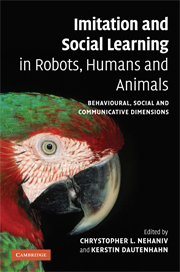 Imitation and Social Learning in Robots, Humans and Animals
Imitation and Social Learning in Robots, Humans and Animals Published online by Cambridge University Press: 10 December 2009
Introduction
The primary aim of research into artificial intelligence is to replicate biological capabilities either through attempting to directly copy biological mechanisms or by engineering solutions from non-biological principles. Either way, the first hurdle is to replicate the behaviour of animals. The biological phenomenon of mimicry includes a range of behaviours that are of particular interest because they represent a signal–receiver relationship in which the interests of both signallers and receivers are much more clearly defined than in many communication systems. Unlike examples of communication such as mate attraction where it is far from clear what the best evolutionary interests of signaller and receiver are, in mimicry it is generally clear that the mimic aims to deceive the receiver and the receiver aims to avoid being deceived. A second interesting feature of mimicry is that it is possible for human observers to estimate how accurate particular examples of mimicry are through their own (albeit subjective) observations. It is striking that examples of mimicry vary substantially in their accuracy, providing information about the selection pressures acting on the evolution of the trait.
Mimicry is widespread in nature and the term encompasses diverse behaviours, morphologies and/or capacities involving three parties (of up to three species): the imitator (mimic), the imitated (model) and the recipient (signal receiver). These terms may refer to one organism resembling another in order to fool a third (as in the familiar butterfly mimics), in other situations they may refer to mechanisms that aid an individual's reproductive success (as in female impersonation by sneaker males), in others again it may refer to complex learned and acquired abilities used to pass skills from one generation to the next within a species (as in primate learning).
To save this book to your Kindle, first ensure [email protected] is added to your Approved Personal Document E-mail List under your Personal Document Settings on the Manage Your Content and Devices page of your Amazon account. Then enter the ‘name’ part of your Kindle email address below. Find out more about saving to your Kindle.
Note you can select to save to either the @free.kindle.com or @kindle.com variations. ‘@free.kindle.com’ emails are free but can only be saved to your device when it is connected to wi-fi. ‘@kindle.com’ emails can be delivered even when you are not connected to wi-fi, but note that service fees apply.
Find out more about the Kindle Personal Document Service.
To save content items to your account, please confirm that you agree to abide by our usage policies. If this is the first time you use this feature, you will be asked to authorise Cambridge Core to connect with your account. Find out more about saving content to Dropbox.
To save content items to your account, please confirm that you agree to abide by our usage policies. If this is the first time you use this feature, you will be asked to authorise Cambridge Core to connect with your account. Find out more about saving content to Google Drive.